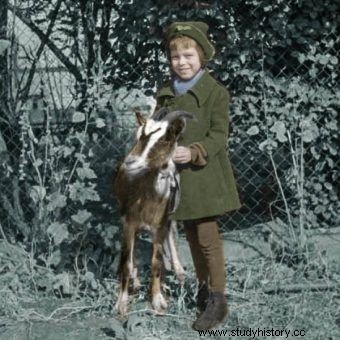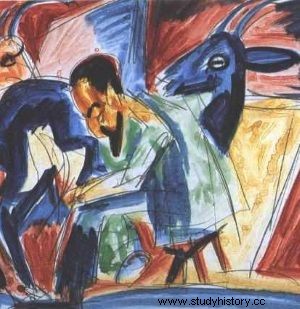They could survive in all conditions. They were feeding on what others did not even want to touch. They saved the lives of thousands of Polish children, but today nobody remembers their hard work under the occupation. It's high time to change that.
During the war, meat was a scarce commodity, but goats were not bred for slaughter. While goat, or goat meat, is sometimes compared to lamb, meat obtained from an older animal is definitely intended for connoisseurs (not to say - eccentrics).
Their main task was to deliver milk. In this matter, they were appreciated not only by Poles, but also by the occupiers. As Czesław Łuczak writes in the book "Population and economic policy of Nazi Germany in occupied Poland", in 1940, the Germans planned to bring as many as 50,000 goats to Polish lands, incorporated into the Reich! 
The population of these animals grew in the Wartheland throughout the occupation. While before the war, in 1937, it was about 160,000 individuals by December 1941, 15,000 goats had arrived, and two years later the total number was 235,000.
Universal Animal
Goats were not subject to registration and tagging regulations, so they were easy to trade, even in secret from the occupiers.

The goat during the war was almost a luxury good (photo published under CC BY-SA 4.0 license, author of Melisa Banchero).
Moreover, their milk - unlike cow's milk - did not have to be compulsorily transferred to the catchment area.
A real blessing for the breeders were also ... goat palates:completely unrefined and ready for almost any occupation diet . All this made goats ideal livestock for the difficult times of war.
This is probably why the Warsaw engineer Symeon Surgiewicz decided to keep a goat in the garden of his house, where he lived in July 1939.
Indiscriminate hosts
A large yard, 20 meters wide and 50 meters long, was more than enough for the needs of ten hens and a horned milk producer.
Flowers, vegetables and fruit trees grew on the property. It was the perfect place for the voracious and omnivorous animal that is the goat.
As Surgiewicz recalls, it was a ginger, unruly cattle that could consume a broom, gnaw the door of a cell, not to mention young branches of fruit trees . These were quite a delicacy for her. Although the owners scolded her for similar actions, they also cared for her very much.

It is hard to imagine that in beautiful Vilnius, on the banks of Wilija, at the foot of Gediminas' Tower, goats were grazed. And yet. (Photo published under CCA 2.0 license by Bernt Rostad)
After all, it was a source of indispensable calcium for them throughout the entire occupation. This put her much higher in the hierarchy than the other animals wandering around the backyards.
Goat as a determinant of wealth
In the suburbs of Warsaw, where Surgiewicz lived, having a goat was a form of ennoblement . It mattered even more than having less and less paper money.
One could even say that there was a kind of return to the Middle Ages and wealth was once again converted into cuckold. The diarist himself stated:
every tenth citizen had a goat here , it follows that the area was prosperous, flowing with goat's milk .
The properties of this occupying ambrosia were also appreciated in other parts of the country. Wilnianka Genowefa Chyczyńska, who was a teenager during the occupation, recalled that the money she earned on tutoring, she donated to her mother for goat milk :
I borrowed her 10 marks for milk, which we were taking from one owner ... a goat. Mrs. Kasejwisowa, a Lithuanian woman living on the Neris River, raised goats. I hated that smell! Disgusting, but the milk was healthy, and who knows, did it not save us from anemia and rickets in those days?
Goats dominated also in small towns, especially in the most modest farms. Not having enough land to feed a cow, and consequently not having a cow, the farmers chose an unruly and noisy, but at the same time cheaper and less demanding alternative.

Ernst Ludwig Kirchner "Farmer Milking a Goat" (Public Domain).
For many families it was a key investment - only the own goat provided the milk the children needed . It was hard to count on the neighbors in this matter. They rarely had any surpluses, and if they did, they would rather sell them than give them up for a song. In the case of cow's milk, there were also official restrictions.
For each animal, the owners had to provide the dairy with the appropriate amount of milk under the quota.
In reports from those days, the memory of carrying a milk can every day to a point located even a few kilometers from home is repeatedly mentioned.
Goat owners were not affected by this problem.
***
"Okupacja od Kuchni" is a moving story about the times when illegal pig slaughtering could lead to Auschwitz, vegetables were grown in the courtyards of tenement houses, and used coffee grounds were traded on the black market. It is also an amazing cookbook:full of original recipes and practical tips from 1939-1945. We recommend!
